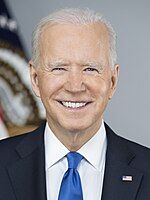| ||||||||||||||||||||||||||
| Turnout | 76.33% (of registered voters) [1] | |||||||||||||||||||||||||
|---|---|---|---|---|---|---|---|---|---|---|---|---|---|---|---|---|---|---|---|---|---|---|---|---|---|---|
| ||||||||||||||||||||||||||
| ||||||||||||||||||||||||||
| ||||||||||||||||||||||||||
| Elections in Nebraska |
|---|
 |
|
|
The 2020 United States presidential election in Nebraska was held on Tuesday, November 3, 2020, as part of the 2020 United States presidential election in which all 50 states plus the District of Columbia participated.[2] Nebraska voters chose electors to represent them in the Electoral College via a popular vote, pitting the Republican Party's nominee, incumbent President Donald Trump, and running mate Vice President Mike Pence against Democratic Party nominee, former Vice President Joe Biden, and his running mate California Senator Kamala Harris. Nebraska has five electoral votes in the Electoral College, two from the state at large, and one each from the three congressional districts.[3]
Located in the conservative Great Plains, Nebraska is one of the most reliably Republican states in the country, having backed the Democratic presidential nominee only once since 1936, during Lyndon B. Johnson's 1964 landslide, and having gone to the Republican nominee by a double-digit margin in every presidential election since. However, Nebraska is one of two states, the other being Maine, to allocate its electoral votes by congressional district. A candidate receives one electoral vote for each district won while the statewide winner receives an additional two electoral votes. Ever since Nebraska first adopted this system in 1992, in practice the Republican nominee has almost always won all three districts, and hence all the state's electoral votes. The first time it split its electoral votes came in 2008 when Barack Obama carried Nebraska's 2nd congressional district, anchored by Omaha, and thus received one electoral vote from the state despite losing statewide. The 2nd district returned to the Republican column in the following two elections, but in 2020 it was considered a key battleground.
Trump carried Nebraska statewide by 19 points on Election Day, down from 25 points in 2016. Biden was able to flip the 2nd district, carrying it by 6.6 points, the best Democratic performance since Nebraska first adopted its system of allocation by district, and the first time in this period that the district has voted more Democratic than the nation. Trump received the state's other four electoral votes. Before the election, all news organizations declared Nebraska a safe red state, while most organizations viewed the 2nd district as either Lean Biden or a tossup. This was the first election in which both Nebraska and Maine would officially split their electoral votes.
Biden won only the two most populous counties in the state: Douglas County, home to Omaha, by 11 points, approximately the same margin Lyndon B. Johnson won the county with in 1964 and the best result for Democrats since that election, and Lancaster County, home to the state's second largest city and state capital Lincoln, where the University of Nebraska is located, by just under 8 points, another 56-year high for Democrats. While he didn't win the state's third largest, Sarpy County, a growing suburban county to the south of Omaha, which in all presidential elections from 1968 to 2016 except 2008 had backed the Republican candidate by at least 21 points, he reduced Trump's winning margin to only 11 points and won 43 percent of the vote there, again a 56-year best for Democrats. Biden also received more than 40 percent of the vote in two counties in the northeastern corner of the state: Thurston County with a Native American majority, and Dakota County with a large Hispanic population.[4]
Per exit polls by the Associated Press, Trump's strength in Nebraska came from whites, who constituted 90% of the electorate, and specifically from Protestants with 70%. Post-election, many rural Nebraskans expressed worries about trade and the economy under a Biden presidency,[5] with 59% of voters stating they trusted Trump more to handle international trade.[6]
Joe Biden improved on Hillary Clinton's performance in Nebraska, as he did in most other states. Nebraska was one of 43 states where the Democratic nominee received a greater proportion of the two-party vote than in the prior election.[a] Despite his loss, Biden's 374,583 votes are the most received by a Democratic candidate for president statewide in Nebraska.
- ^ "Voter Turnout". Nebraska Secretary of State Election Results. November 6, 2020. Retrieved December 1, 2020.
- ^ Kelly, Ben (August 13, 2018). "US elections key dates: When are the 2018 midterms and the 2020 presidential campaign?". The Independent. Archived from the original on August 2, 2018. Retrieved January 3, 2019.
- ^ "Distribution of Electoral Votes". National Archives and Records Administration. Retrieved January 3, 2019.
- ^ Leip, Dave. "2020 Presidential General Election Results - Nebraska". Dave Leip's Atlas of U.S. Presidential Elections.
- ^ Searcey, Dionne (November 8, 2020). "A Nation Votes for Joe Biden, and a Red State Shrugs". The New York Times. ISSN 0362-4331. Retrieved November 9, 2020.
- ^ "Nebraska Voter Surveys: How Different Groups Voted". The New York Times. November 3, 2020. ISSN 0362-4331. Retrieved November 9, 2020.
Cite error: There are <ref group=lower-alpha> tags or {{efn}} templates on this page, but the references will not show without a {{reflist|group=lower-alpha}} template or {{notelist}} template (see the help page).
© MMXXIII Rich X Search. We shall prevail. All rights reserved. Rich X Search





